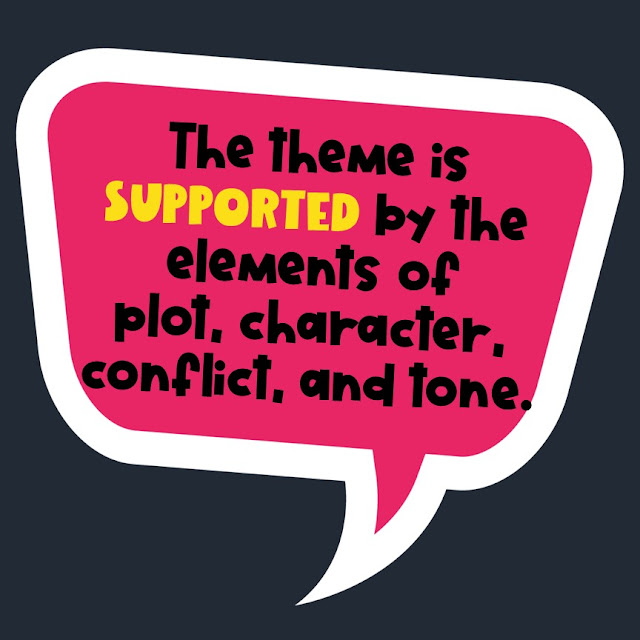Theme is such an important concept when teaching reading. Students are asked to determine the theme of a text over and over again. However, many students struggle with how to identify the theme. That's why I'm sharing some of my favorite ways to teach theme. You'll find theme lesson ideas, theme activities, and theme passage suggestions to help your students finally figure out how to find theme!
Sometimes when thinking about theme it is easiest to think about what it is not. Theme is NOT the subject of the text. The subject would be a single word like "childhood" or "friendship." It is NOT a summary. A summary would be several sentences describing the text. Instead, it is the underlying idea of a text. It is what the writer wishes to convey about the subject. Therefore, it is usually written in a phrase or clause.
When teaching theme, I find that it's best to introduce the critical components of theme through notes and a class discussion. My favorite kind of notes are theme doodle notes, of course. Since doodles are more engaging, they're a great way to get students focused as you begin teaching about theme. Once students have a general understanding of theme, you might want to have a discussion with students.During the discussion ask students to think of texts that have a theme like "Be careful what you wish for" or "Never give up on your dreams." Then, have students discuss the theme of fairytales or fables like "Beauty and Beast" and "Goldilocks and the Three Bears." The notes and discussion will drive home the idea that the theme is not a single word subject, nor is it a multi-sentence summary. Students will realize that the theme is a truth about life revealed in a phrase or clause.
A work's theme can apply to multiple texts. When you teach about theme you'll want to help students realize that themes need to be general enough to apply to many different texts. Take the theme "Be careful what you wish for." That theme can apply to "The Little Mermaid," "Jack and the Beanstalk," and even "Macbeth." It's important for students to realize that themes are universal.
You'll also want to expose students to different genres of writing so that students understand that themes are evident in all writing including fiction, nonfiction, prose, and poetry. I've compiled different genres in this theme unit.Since poems are short and compressed, I love using poems to help students develop an understanding of theme. Take a poem like, "Life Doesn't Frighten Me" by Maya Angelou. In Angelou's poem, the speaker is a child. Angelou's message and the poem's theme is to "be brave when faced with your fears." You might share poems like this or some of my other favorites to help students read several texts and practice determining universal themes.
The theme is the message that the writer wishes to reveal about its subject. It's what the reader is supposed to learn about life after reading the text. Therefore, it is usually not directly stated in the work. Instead, students will need to think about the plot, conflict, characters, and setting and then make an inference or educated guess. When students consider all the elements of the text, they'll need to infer the theme.
One way to help students understand that the story is built around the theme is to have them develop their own stories with a theme in mind. At first, you can have students do this by providing them with themes that they will need to portray in a comic strip or skit. For instance, you might have students doodle a comic for the theme "Two heads are better than one." Or, you could have students work in small groups to come up with a skit that has the theme "Friends always show up when you need them." By writing their own texts, students will begin to see how the theme is infused throughout the work.
As students determine the theme of a passage, they'll need to consider a text's plot, characters, conflict, and tone. In other words, they need to think about the entire writing piece and reflect on its message about life. That can be challenging for students.
That's why I like to give students many opportunities to practice finding the theme. Task cards and mini-passages work especially great for this. I've taken the idea of theme task cards even further with Learning Take Out activities. Students read fiction and nonfiction passages that they grab from take out containers. The passages are the perfect way for students to develop the ability to identify a text's theme.
-------------------------------------------------
As you can tell, there are many ways to teach theme. I think the more chances we can give students to develop their reading skills, the better! If you're looking for some ready-to-teach resources, grab these THEME resources:
Thanks for stopping by!
Mary Beth
P.S. Here's my latest resource for teaching theme!











I appreciate how you broke down the complex ideas! This was a pleasure to read. Keep up the fantastic work!
ReplyDeleteThis comment has been removed by a blog administrator.
ReplyDelete